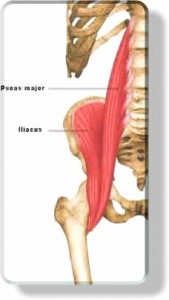If you participate in sports that use a lot of kicking motions, there is a chance that you can strain your hip flexor. It commonly occurs when you do an explosive movement, take off or accelerate quickly. However repetition and stress on the muscle can also cause the injury. Sprints, soccer, karate, and football are examples of sports that utilize these muscles and athletes that regularly play these sports are at a higher risk. Being aware of this injury and having some idea of hip flexor strain treatment can help you be more prepared should it happen to you or a teammate.
What Happens When You Strain a Hip Flexor?
The hip flexors are the muscles that connect your front hip to your thigh bone. Anytime you move your knee up towards your chest you are using these muscles. The consist of the Psoas, Illiacus and the Rectus Femoris. Whenever they are contracted or stretched out there is some tension placed upon them. An injury occurs when the fibers of these muscles are damaged. There is a range of injury, sometimes the pain in minimal and you may just feel a little sore. If the fibers are further damaged there will be some loss of movement. A severe strain will result in extreme pain and a major loss of movement.

Pic: fitstep.com
What Are Common Symptoms?
Most people who experience any hip flexor strain symptoms will know right away that something is wrong. There will be a sudden and sharp pain or pulling sensation in the front part of your hip. If the injury is minimal, you might be able to continue on with your activity. In more extreme cases, there will be intense pain, muscle spasms, and you will not be able to continue with your activity. If it is a serious strain, you may have trouble walking. It is common for you to experience some stiffness and bruising the next morning, even if the strain was not severe.
What Are the Causes of a Hip Flexor Strain?
The most common cause is incorrect or insufficient warm up. Stretching when the muscles are not properly warmed up can cause the muscles to contract suddenly, which in turn causes injury. Remember that static stretching before explosive work isn’t the best idea, you tend to relax the muscle and it is not in an ideal state to accelerate and produce force. They may also occur when you are doing activities that largely rely on those muscles, such as kicking or sprinting. Explosive use of the muscle can also result in an injury. like if a kick boxer throws a powerful front kick when he or she is not yet warmed up. It is also possible to develop this injury over time from repetitive use. If you suffer from muscle imbalances, tight and weak hip flexors or have some technical and biomechanical issue then you put yourself at a higher risk of a hip flexor strain.
How Is It Treated?
There are hip flexor strain treatment exercises. These are designed to reduce recovery time and to prevent stiffness and swelling. However, always follow the instructions from your own doctor or other health care professional. These can all be done 3 times a day, providing that there is no pain.
One exercise is essentially a knee lift. Stand with something stable to hold onto, like a wall. In a slow and controlled motion, lift your knee up towards your chest and then lower it. Only move as much as you can without pain. Aim for 10 repetitions.
You can also perform a hip extension in a laying position. Lay down on a bed or table on your back with your butt almost all the way to the edge. Place both hands on your non-injured knee and slowly pull it to your chest. Let your injured leg dangle off the edge. Hold this position for 2-5 seconds and then release in a controlled and slow manner. Repeat this 10 times as long as you do not feel pain.
Hip flexor strain recovery time is approximately 1-3 weeks for minor to moderate injuries, and 4-8 weeks for more severe ones. Understand this injury and your treatment options. Take care of yourself and you can get back to your activity soon!